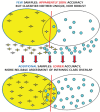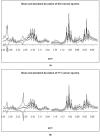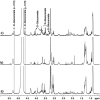MRS-based Metabolomics in Cancer Research
- PMID: 25114549
- PMCID: PMC4122556
- DOI: 10.4137/MRI.S13755
MRS-based Metabolomics in Cancer Research
Abstract
Metabolomics is a relatively new technique that is gaining importance very rapidly. MRS-based metabolomics, in particular, is becoming a useful tool in the study of body fluids, tissue biopsies and whole organisms. Advances in analytical techniques and data analysis methods have opened a new opportunity for such technology to contribute in the field of diagnostics. In the MRS approach to the diagnosis of disease, it is important that the analysis utilizes all the essential information in the spectra, is robust, and is non-subjective. Although some of the data analytic methods widely used in chemical and biological sciences are sketched, a more extensive discussion is given of a 5-stage Statistical Classification Strategy. This proposes powerful feature selection methods, based on, for example, genetic algorithms and novel projection techniques. The applications of MRS-based metabolomics in breast cancer, prostate cancer, colorectal cancer, pancreatic cancer, hepatobiliary cancers, gastric cancer, and brain cancer have been reviewed. While the majority of these applications relate to body fluids and tissue biopsies, some in vivo applications have also been included. It should be emphasized that the number of subjects studied must be sufficiently large to ensure a robust diagnostic classification. Before MRS-based metabolomics can become a widely used clinical tool, however, certain challenges need to be overcome. These include manufacturing user-friendly commercial instruments with all the essential features, and educating physicians and medical technologists in the acquisition, analysis, and interpretation of metabolomics data.
Keywords: cancer; classification; diagnosis; magnetic resonance spectroscopy; metabolomics.
Figures




Similar articles
-
Nuclear magnetic resonance spectroscopy of human body fluids and in vivo magnetic resonance spectroscopy: Potential role in the diagnosis and management of prostate cancer.Urol Oncol. 2020 Apr;38(4):150-173. doi: 10.1016/j.urolonc.2019.10.019. Epub 2020 Jan 11. Urol Oncol. 2020. PMID: 31937423 Review.
-
Development and applications of in vivo clinical magnetic resonance spectroscopy.Prog Biophys Mol Biol. 1996;65(1-2):45-81. doi: 10.1016/s0079-6107(96)00006-5. Prog Biophys Mol Biol. 1996. PMID: 9029941 Review.
-
Recent and potential developments of biofluid analyses in metabolomics.J Proteomics. 2012 Feb 2;75(4):1079-88. doi: 10.1016/j.jprot.2011.10.027. Epub 2011 Nov 4. J Proteomics. 2012. PMID: 22079244 Review.
-
Characterizing human cancer metabolomics with ex vivo 1H HRMAS MRS.Technol Cancer Res Treat. 2010 Aug;9(4):381-91. doi: 10.1177/153303461000900407. Technol Cancer Res Treat. 2010. PMID: 20626203 Review.
-
MRS as endogenous molecular imaging for brain and prostate tumors: FP6 project "eTUMOR".Adv Exp Med Biol. 2006;587:285-302. doi: 10.1007/978-1-4020-5133-3_22. Adv Exp Med Biol. 2006. PMID: 17163172 Review.
Cited by
-
Novel Approaches to Imaging Tumor Metabolism.Cancer J. 2015 May-Jun;21(3):165-73. doi: 10.1097/PPO.0000000000000111. Cancer J. 2015. PMID: 26049695 Free PMC article. Review.
-
The therapy of gefitinib towards breast cancer partially through reversing breast cancer biomarker arginine.Afr Health Sci. 2015 Jun;15(2):594-7. doi: 10.4314/ahs.v15i2.36. Afr Health Sci. 2015. PMID: 26124808 Free PMC article.
-
Correlation of MR-Based Metabolomics and Molecular Profiling in the Tumor Microenvironment of Temozolomide-Treated Orthotopic GL261 Glioblastoma in Mice.Int J Mol Sci. 2023 Dec 18;24(24):17628. doi: 10.3390/ijms242417628. Int J Mol Sci. 2023. PMID: 38139457 Free PMC article.
-
MR spectroscopy in breast cancer metabolomics.Anal Sci Adv. 2021 May 3;2(11-12):564-578. doi: 10.1002/ansa.202000160. eCollection 2021 Dec. Anal Sci Adv. 2021. PMID: 38715862 Free PMC article. Review.
-
Biomarkers in preclinical cancer imaging.Eur J Nucl Med Mol Imaging. 2015 Apr;42(4):579-96. doi: 10.1007/s00259-014-2980-7. Epub 2015 Feb 12. Eur J Nucl Med Mol Imaging. 2015. PMID: 25673052 Free PMC article. Review.
References
-
- Nikulin AE, Brière KM, Friesen L, Smith ICP, Somorjai RL. Genetic algorithm-guided optimal attribute selection: a novel preprocessor for classifying MR spectra; Proceedings of Society of Magnetic Resonance, Third Scientific Meeting; Nice, France. 1995, 19–25 August, #1940.
-
- Nikulin AE, Dolenko B, Bezabeh T, Somorjai RL. Near-optimal region selection for feature space reduction: novel preprocessing methods for classifying MR spectra. NMR Biomed. 1998;11:209–16. - PubMed
-
- Sletten E, Kvalheim OM, Kruse S, Farstad M, Søreide O. Detection of malignant tumours—multivariate analysis of proton NMR spectra of serum. Euro J Cancer. 1990;26:615–8. - PubMed
-
- Wold S. Discussion: PLS in chemical practice. Technometrics. 1993;35:136–9.
Publication types
LinkOut - more resources
Full Text Sources
Other Literature Sources
Medical

